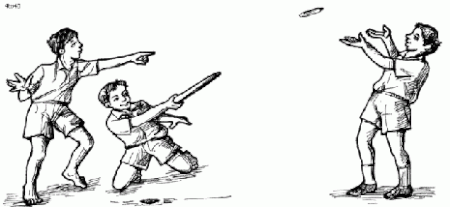Dandi Biyo
Dandi Biyo (Nepali) is a game usually played in rural Nepal and was considered the national game unofficially until May 23, 2017, when officially Dandibiyo was declared as the national sports. Dandibiyo was declared as the national game of Nepal in 23 May 2017. Dandi Biyo is played with a stick (Dandi) about two feet long and a wooden pin (Biyo) about six inches long. The pin is a small wooden stick with pointed ends. It is similar to the Indian game Gilli Danda. The government has not implemented any policies for the preservation of Dandi Biyo, and along with decreasing players[1], the game is expected to be extinct soon.[2]

Gameplay
Dandi Biyo is played by two or more players. The wooden pin is laid across a four-inch-deep hole in the ground. One player puts one end of the stick inside the hole and holds the other end. The player jerks the stick against the pin to launch the pin into the air while other players called 'fielders' try to catch the pin. If one of the fielders catch the pin in the air, the turn is over and the catcher takes the stick. If the pin instead hits the ground, that player plays to score. One of the fielders then throws the pin into the hole while the player tries to hit and throw the pin away. If the pin goes into the hole, the player's turn is over and the points accumulated by the player automatically becomes zero. If the pin doesn't go into the hole, the player plays to score by hitting the pin at one end by the stick. In another version of the game, a circular boundary of about one-meter diameter is drawn on the ground. The player throws the pin into the circle from a distance of about two meters. If the pin lies within the circle the player continues to play and score.
To score, a player again knocks the pin in the air. Before it lands, the player hits it as many times as possible, to move it away from the hole. This process is repeated three times in which the player tries to throw the pin as far as he can. The score is calculated by multiplying the number of hits by the number of stick lengths the pin traveled. If the player hits the pin twice in the air, the score will be twice the number of stick lengths the pin traveled.
The game was mostly played by Nepali youths and was very popular between 1980's and 1990's when modern toys and games were not available. Sonam Ukyab from Purano Baneswore is unofficially considered the best Dandi Biyo player of all time.
Dandi Biyo is one of many such games that were locally developed in the rural areas reflecting use of local tools and techniques. In the context of modern games, Dandi Biyo is very close to cricket. The player can be compared to the "batsman" and the other players to the "fielders".
Dandi Biyo Association was established about two decades ago as the sports governing body. Dandi Biyo event happens every year on the occasion of Public Service Day, which falls on the first week of September.
Tip-Cat is a similar British game, and Gillidanda is a similar Indian game.
See also
References
- "Nepal's' 'national sport' we never had: Five things you didn't know about dandi-biyo – OnlineKhabar". Onlinekhabar.com. Retrieved 7 January 2019.
- "Save Dandi Biyo". Meronepalma.com. Archived from the original on 2 July 2014. Retrieved 2 July 2015.
3. allitfeed